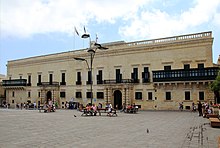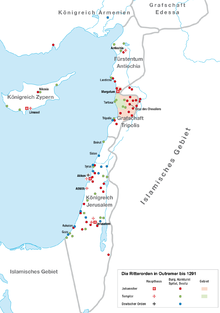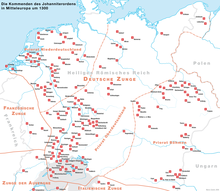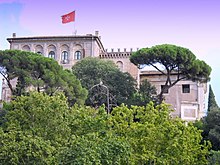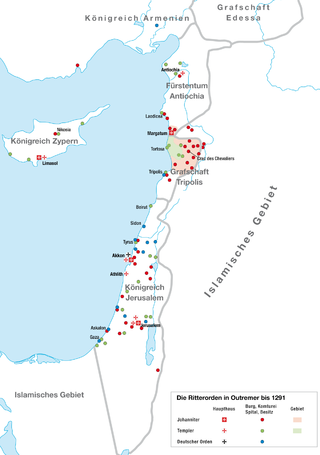
A military order is a Christian religious society of knights. The original military orders were the Knights Templar, the Knights Hospitaller, the Order of Saint James, the Order of Calatrava, and the Teutonic Knights. They arose in the Middle Ages in association with the Crusades, both in the Holy Land, the Baltics, and the Iberian peninsula; their members being dedicated to the protection of pilgrims and Christians, as well as the defence of the Crusader states. They are the predecessors of chivalric orders.
The Russian tradition of the Knights Hospitaller is a collection of charitable organisations claiming continuity with the Russian Orthodox grand priory of the Order of Saint John. The order emerged when Malta was captured by Napoleon in 1798 during the expedition to Egypt. The Grand Master at the stronghold of Malta, Ferdinand von Hompesch, failed to anticipate or prepare for the threat. The Order continued to exist in a diminished form and negotiated with European governments for a return to power. The Emperor of Russia gave shelter to the largest number of Knights in St Petersburg and this gave rise to the Russian tradition of the Knights Hospitaller and recognition within the Russian Imperial Orders. In gratitude the Knights declared Ferdinand von Hompesch deposed and Emperor Paul I was elected as the new Grand Master. The continuous Order was also approved by the Papacy, but due to British fear of Russian taking presence in the Mediterranean and because many knights were Orthodox the Order became de facto the traditional Order but de jure not recognised similar or at par with the formation of the 19th-century Sovereign Military Order of Malta.

Roger de Moulins was the eighth Grand Master of the Knights Hospitaller from 1177 until his death in 1187. He succeeded Jobert of Syria. His successors were two interim masters, William Borrel and then Armengol de Aspa, before the permanent Grand Master Garnier of Nablus was selected in 1190.
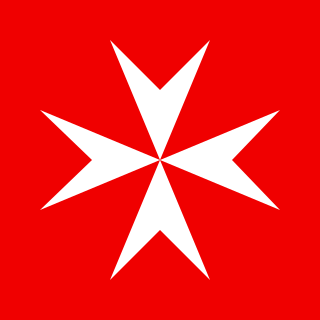
The Bailiwick of Brandenburg of the Chivalric Order of Saint John of the Hospital at Jerusalem, commonly known as the Order of Saint John or the Johanniter Order, is the German Protestant branch of the Knights Hospitaller, the oldest surviving chivalric order, which generally is considered to have been founded at Jerusalem in 1099.

Rothley Temple, or more correctly Rothley Preceptory, was a preceptory in the village of Rothley, Leicestershire, England, associated with both the Knights Templar and the Knights Hospitaller.

The Knights Templar, full name The United Religious, Military and Masonic Orders of the Temple and of St John of Jerusalem, Palestine, Rhodes and Malta, is a fraternal order affiliated with Freemasonry. Unlike the initial degrees conferred in a regular Masonic Lodge, which only require a belief in a Supreme Being regardless of religious affiliation, the Knights Templar is one of several additional Masonic Orders in which membership is open only to Freemasons who profess a belief in Christianity. One of the obligations entrants to the order are required to declare is to protect and defend the Christian faith. The word "United" in its full title indicates that more than one historical tradition and more than one actual order are jointly controlled within this system. The individual orders 'united' within this system are principally the Knights of the Temple, the Knights of Malta, the Knights of St Paul, and only within the York Rite, the Knights of the Red Cross.
In the Middle Ages, a commandery was the smallest administrative division of the European landed properties of a military order. It was also the name of the house where the knights of the commandery lived. The word is also applied to the emoluments granted to a commander. They were the equivalent for those orders to a monastic grange. The knight in charge of a commandery was a commander.

The Order of Knights of the Hospital of Saint John of Jerusalem, commonly known as the Knights Hospitaller, was a medieval and early modern Catholic military order. It was founded in the Kingdom of Jerusalem in the 12th century and had headquarters there until 1291, thereafter being based in Kolossi Castle in Cyprus (1302–1310), the island of Rhodes (1310–1522), Malta (1530–1798), and Saint Petersburg (1799–1801).

The history of Rhodes under the Order of Saint John lasted from 1310 until 1522. The island of Rhodes was a sovereign territorial entity of the Knights Hospitaller who settled on the island from Palestine and from Cyprus, where they did not exercise temporal power. The first Grand Master was the French Foulques de Villaret (1305–1319).

Jean de Villiers was the twenty-second Grand Master of the Knights Hospitaller, serving from 1285 until 1293. He was elected Grand Master after the death of Nicolas Lorgne. De Villiers was Prior of France beginning in 1282 and he remained in France to deal with existing problems of the Order. Jacques de Taxi became Grand Master ad interim, perhaps through 27 June 1286, while awaiting the arrival of the newly elected Grand Master in the Holy Land. De Villiers was present at the Siege of Acre in 1291, but escaped just before the city fell to the Mamluks. He was succeeded by Odon de Pins.

The flag and coat of arms of the Sovereign Military Order of Malta, or the Jerusalem flag, display a white cross on a red field, ultimately derived from the design worn by the Knights Hospitaller during the Crusades.

The Order of Saint John was organised in a system of commanderies during the high medieval to early modern periods, to some extent surviving as the organisational structure of the several descended orders that formed after the Reformation.

Nicolas Lorgne was the twenty-first Grand Master of the Knights Hospitaller, serving first from 1277 until 1285 and was the successor to Hugues de Revel. He was succeeded by Jean de Villiers, with Jacques de Taxi acting as Grand Master ad interim while de Villiers was en route to the Holy Land.

Hugues de Revel was an English knight who became the twentieth Grand Master of the Knights Hospitaller, serving from 1258 to 1277 as the successor to Guillaume de Chateauneuf. He was succeeded by Nicolas Lorgne.

Geoffroy de Donjon, also known as or Geoffroy de Duisson, was the eleventhth Grand Master of the Knights Hospitaller serving from 1193 through his death in 1202. He succeeded Garnier de Nablus who died in August 1192.

Pierre de Vieille-Brioude, or Vieille-Bride, was a nobleman from Auvergne who was the eighteenth Grand Master of the Knights Hospitaller between 1240 and 1242, succeeding Bertrand de Comps. He was succeeded by Guillaume de Chateauneuf.

Guillaume de Chateauneuf was the nineteenth Grand Master of the Knights Hospitaller, serving first from 1242–1244 as the successor to Pierre de Vieille-Brioude. He was captured during the Battle of La Forbie in 1244, held hostage in Egypt and ransomed through the Sixth Crusade. During his captivity, his position was filled on an interim basis by Jean de Ronay. De Ronay died in 1250, and de Chateauneuf was released shortly thereafter. He was succeeded by Hugues de Revel.

Armengol de Aspa, also known as Hermangard d'Asp, was the ninth Grand Master of the Knights Hospitaller, holding the office from 1188 until his resignation in 1189 or 1190. He succeeded William Borrel who was interim Grand Master. It was under his magistracy that the headquarters of the Order was transferred from Jerusalem to Tyre. It was probably during the winter of 1189 or 1190 that Armengol's magistracy ceased, but this was not due to his death, since he appears again as lord of Amposta from December 1190 to April 1191. We have no information on what this first abdication in the history of the Order was, but he was succeeded by Garnier de Nablus sometime in 1190.

The history of the Knights Hospitaller in the Levant is concerned with the early years of the Order of the Hospital of St. John of Jerusalem, the Knights Hospitaller, through 1309. The Order was formed in the later part of the eleventh century and played a major role in the Kingdom of Jerusalem, in particular, the Crusades. This lasted until the West was expelled from the Holy Land, with the Order conquering Rhodes in the early fourteenth century. Among the most important internal events of the early years of the kingdom were the foundation of the Military Orders, which included the Hospitallers, the Knights Templar and the Teutonic Order. Unlike the Hospitallers' beginnings as a benevolent organization, the Templars and Teutonic knights began with a military mission. These three major Orders would play a major role in the military activities of the kingdom, sometimes cooperatively, sometimes not. On the battlefield they frequently shared among them the most important tactical roles, the vanguard and rear-guard.

